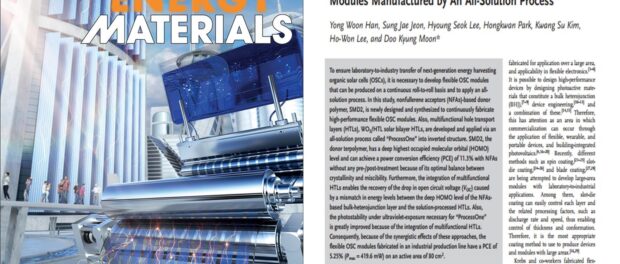‘인쇄되는 전지 모듈’ 개발
건국대, 코오롱과 종이처럼 인쇄되는 ‘유연 유기태양전지 모듈’ 개발…‘Advanced Energy Materials’ 표지 선정
 건국대학교 공과대학 화학공학부 문두경 교수 연구팀(나노 및 정보소재 연구실)은 코오롱인더스트리·코오롱미래기술원과 공동으로 스크린 프린트 기법만으로 넓은 면적의 유연 유기 태양전지를 종이처럼 인쇄할 수 있는 모듈을 처음으로 개발했다고 21일 밝혔다. 사진은 건국대 문두경 교수 팀이 발표 한 Advanced Energy Materials 저널의 표지 논문. 사진=건국대
건국대학교 공과대학 화학공학부 문두경 교수 연구팀(나노 및 정보소재 연구실)은 코오롱인더스트리·코오롱미래기술원과 공동으로 스크린 프린트 기법만으로 넓은 면적의 유연 유기 태양전지를 종이처럼 인쇄할 수 있는 모듈을 처음으로 개발했다고 21일 밝혔다. 사진은 건국대 문두경 교수 팀이 발표 한 Advanced Energy Materials 저널의 표지 논문. 사진=건국대
종이처럼 ‘인쇄할 수 있는 전지 모듈’이 개발됐다.
건국대학교 공과대학 화학공학부 문두경 교수 연구팀(나노 및 정보소재 연구실)은 코오롱인더스트리·코오롱미래기술원과 공동으로 스크린 프린트 기법만으로 넓은 면적의 유연 유기 태양전지를 종이처럼 인쇄할 수 있는 모듈을 처음으로 개발했다고 21일 밝혔다.
건국대와 코오롱 연구팀의 ‘인쇄 공정에 의한 차세대 비(非)풀러렌(Fullerene) 계열 유연 유기 태양전지 모듈 개발’ 연구 결과는 재료공학 및 물리화학 분야 상위 2% 이내 국제 학술지인 『Advanced Energy Materials』(영향력 지수(IF)=24.884)에 개재됐으며, 2019년 42호 표지 논문으로 선정됐다.
논문 제목은 「Evaporation-Free Nonfullerene Flexible Organic Solar Cell Modules Manufactured by An All-Solution Process, DOI」다. DOI는 ‘디지털 객체 식별자(Digital Object Identifier)’를 말하며 논문은 DOI 웹사이트(https://doi.org/10.1002/aenm.201902065)에서 확인할 수 있다.
차세대 태양 전지로 부각되고 있는 유기 태양전지는 작은 면적에서 진공 증착 공정에 의해 고성능을 달성할 수 있었으나 상용화를 위해 대면적화, 유연화 및 탈(脫) 증착 공정의 이슈가 필요했다.
문 교수 연구팀은 이를 극복하기 위해 자체 연구 개발된 비(非)풀러렌계 도너 소재(SMD2)와 HTL소재(OLED용 유기소재)를 도입해 세계 최초로 slot-die coating과 screen printing 기법만으로 ㈜코오롱인더스트리/코오롱미래기술원 연구팀과 공동으로 유연 유기 태양전지 모듈을 개발했다.
이를 통해 유기 태양전지 상용화의 큰 난제였던 비(非)풀러렌계 소재의 면적을 크게 넓히는 과정에서 발생되는 효율과 안정성 감소를 성공적으로 극복했다.
문 교수팀이 자체 개발한 도너소재 (SMD2)와 층간 소재, 독자의 소자 구조(효율 11.6%)를 도입해 코오롱인더스트리의 유기 태양전지 생산 라인에서 제조된 대면적 유연 모듈(광활성 면적= 80 cm2)은 효율 5.25%에 419.6 mW의 출력을 나타냈다.
이는 기존의 진공 증착 없이 연속공정으로 고출력의 유연 유기 태양전지 모듈을 제작 할 수 있는 결과로 유기 태양전지의 상용화를 한층 앞당길 수 있는 결과로 평가 받았다.
문두경 교수는 “이번 연구결과는 최근 화두가 되고 있는 한일 간 소재 원천기술 경쟁과 소재 국산화 등의 이슈 가운데 얻은 결과로 더욱 의미 있다”며 “앞으로 휴대용 충전기, 차량용 태양전지(automobile integrated photovoltaics, AIPVs), 건물일체형 태양전지(building integrated photovoltaics, BIPVs) 등 다양한 분야에 적용이 가능할 것으로 전망한다”고 말했다.
문두경 건국대 교수팀은 최근 한계극복형 알키미스트 프로젝트로 투명 유기 태양전지(20% 이상의 효율 달성을 위한 소재 연구 및 투명 태양전지 효율 12% 달성 목표) 연구과제에 선정되면서 유기 반도체 소재와 소자 연구 분야에서 신기술을 선도하는 연구결과를 지속적으로 발표하고 있으며 유기 태양전지 분야 최고 연구기관으로 주목받고 있다.
이번 연구는 미래창조과학부 에너지기술개발사업과 인력양성사업 지원을 받아 수행됐으며, 한용운·전성재 건국대 박사가 공동 제1저자, 이형석 석사 과정, 박홍관 코오롱인더스트리·코오롱미래기술원 책임연구원, 김광수 책임연구원, 이호원 제주대학교 교수가 공동저자로 참여했다.
Abstract
To ensure laboratory‐to‐industry transfer of next‐generation energy harvesting organic solar cells(OSCs), it is necessary to develop flexible OSC modules that can be produced on a continuous roll-to-roll basis and to apply an all-solution process. In this study, nonfullerene acceptors(NFAs)‐based donor polymer, SMD2, is newly designed and synthesized to continuously fabricate high-performance flexible OSC modules. Also, multifunctional hole transport layers(HTLs), WO3/HTL solar bilayer HTLs, are developed and applied via an all-solution process called “ProcessOne” into inverted structure. SMD2, the donor terpolymer, has a deep highest occupied molecular orbital (HOMO) level and can achieve a power conversion efficiency(PCE) of 11.3% with NFAs without any pre-/post-treatment because of its optimal balance between crystallinity and miscibility. Furthermore, the integration of multifunctional HTLs enables the recovery of the drop in open circuit voltage(VOC) caused by a mismatch in energy levels between the deep HOMO level of the NFAs‐based bulk‐heterojunction layer and the solution‐processed HTLs. Also, the photostability under ultraviolet‐exposure necessary for “ProcessOne” is greatly improved because of the integration of multifunctional HTLs. Consequently, because of the synergistic effects of these approaches, the flexible OSC modules fabricated in an industrial production line have a PCE of 5.25%(Pmax=419.6mW) on an active area of 80cm2.

Leave a comment
You must be logged in to post a comment.